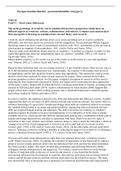Enrique Sarabia Sánchez - personal identifier: G6533073
TMA 02
PART 1 – Word Limit 1500 words
The social psychology of creativity can be considered from three perspectives which focus on
different aspects of creativity: contexts, collaborations, and cultures. Compare and contrast these
three perspectives, drawing on examples from relevant theory and research.
Creativity can be defined as the skill that allows us to create something new or to solve a problem
differently, also this term used to be associated with the imagination. The psychologist Mihaly suggests
that being creative involves a state of concentration which he calls “flow” and that this is also the state in
which people are happiest (Csikszentmihalyi, 1997, cited in Taylor and Turner, 2016).
There are many more definitions about creativity as Amabile’s: “A product or response is creative to the
extent that appropriate observers independently agree it is creative” (Amabile, 1983. p. 359, cited in
Taylor and Turner, 2016).
Mason defines creativity as “To create is to act in the world, or on the world, in a new and significant
way” (Mason, 2003, p.7, cited in Taylor and Turner, 2016).
Based on these definitions how can we evaluate creativity? as per Amabile's theory, there are two ways to
do it, the operational and the theoretical way. Operationally, the response or the product must be novel
and appropriate and the task should be heuristic rather than algorithmic. This means that creative works
must be useful when analyzed by observers and must also be unique. These creations do not follow
previous guidelines in their creation. For this paper, Amabile's description of creativity will be used in
analysing the three frameworks discussed by Taylor and Turner and in contrasting the three approaches
of this study: creative frameworks in which the focus is on the personal skills of creators, according to the
research of Glăveanu and Lubart (2014); creative collaborations in which Steiner (2000) suggests that
people will be more creative when working in teams; and, to finish the framework in which the groups
and cultures studied by Halsem and others (2013).
In creative contexts, the emphasis is placed on the skills and motivations that influence creation. Amabile
suggested that there are two types of skills: domain-relevant and creativity-relevant. The former refers to
technical knowledge of a given field. Outside psychology these skills are commonly referred to as talents,
but Amabile defined talent as an innate and unlearned ability, arguing that almost all domain-relevant
skills are acquired through training and education. This skill is necessary for creativity as Amabile’s
definition requires the product to be novel and appropriate so it is imperative to know what is already
available. However, creativity-relevant skills are deemed more general and a combination of hard work to
acquire knowledge and persevere, and play to experiment with ideas. There were also two types of
motivation to this work; intrinsic and extrinsic. Intrinsic relates to what is inside the individual, a desire to
"engage in an activity if such engagement is viewed as an end in itself and not as a means to some
extrinsic goal" (1983, p.366, cited in Taylor and Turner, 2016). On the other hand, extrinsic motivation
refers to "attaining a reward or meeting a deadline or achieving the approval of an observer or obtaining a
positive evaluation from an expert" (1983, p. 371, cited in Taylor and Turner, 2016).
Glaveanu and Lubart invite participants to make their own opinions about what "constitutes creative
work" (Open University, 2016). To examine the relevance of interactions in this framework by asking a
group of creative people questions about what has influenced their work and how the interrelationships
have had a positive impact. The report revealed that participants reported being affected by family,
colleagues, friends, both positively and negatively. The Ambile’s model was shown to work through
evidence of important skills in the area of creativity and mastery, it was found that the family
environment influenced the development of creativity, that intrinsic motivation was an internal need to
express oneself through creativity and that extrinsic motivation was the reward for success. This study
also showed that some of the people have a preference for teamwork and Glăveanu and Lubart pointed




